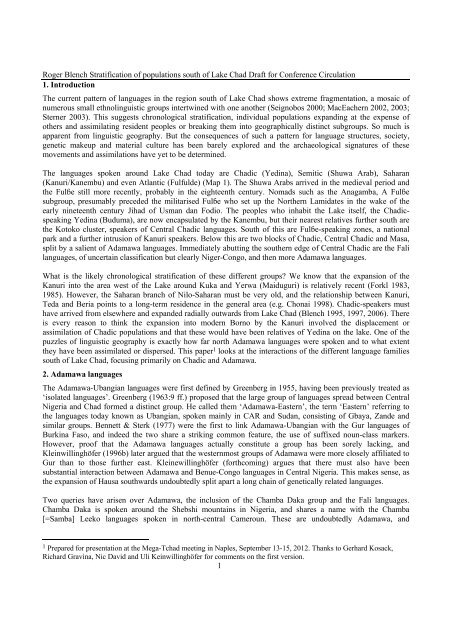Linguistic evidence for the chronological ... - Roger Blench
Linguistic evidence for the chronological ... - Roger Blench
Linguistic evidence for the chronological ... - Roger Blench
Create successful ePaper yourself
Turn your PDF publications into a flip-book with our unique Google optimized e-Paper software.
<strong>Roger</strong> <strong>Blench</strong> Stratification of populations south of Lake Chad Draft <strong>for</strong> Conference Circulation<br />
1. Introduction<br />
The current pattern of languages in <strong>the</strong> region south of Lake Chad shows extreme fragmentation, a mosaic of<br />
numerous small ethnolinguistic groups intertwined with one ano<strong>the</strong>r (Seignobos 2000; MacEachern 2002, 2003;<br />
Sterner 2003). This suggests <strong>chronological</strong> stratification, individual populations expanding at <strong>the</strong> expense of<br />
o<strong>the</strong>rs and assimilating resident peoples or breaking <strong>the</strong>m into geographically distinct subgroups. So much is<br />
apparent from linguistic geography. But <strong>the</strong> consequences of such a pattern <strong>for</strong> language structures, society,<br />
genetic makeup and material culture has been barely explored and <strong>the</strong> archaeological signatures of <strong>the</strong>se<br />
movements and assimilations have yet to be determined.<br />
The languages spoken around Lake Chad today are Chadic (Yedina), Semitic (Shuwa Arab), Saharan<br />
(Kanuri/Kanembu) and even Atlantic (Fulfulde) (Map 1). The Shuwa Arabs arrived in <strong>the</strong> medieval period and<br />
<strong>the</strong> Fulɓe still more recently, probably in <strong>the</strong> eighteenth century. Nomads such as <strong>the</strong> Anagamba, A Fulɓe<br />
subgroup, presumably preceded <strong>the</strong> militarised Fulɓe who set up <strong>the</strong> Nor<strong>the</strong>rn Lamidates in <strong>the</strong> wake of <strong>the</strong><br />
early nineteenth century Jihad of Usman dan Fodio. The peoples who inhabit <strong>the</strong> Lake itself, <strong>the</strong> Chadicspeaking<br />
Yedina (Buduma), are now encapsulated by <strong>the</strong> Kanembu, but <strong>the</strong>ir nearest relatives fur<strong>the</strong>r south are<br />
<strong>the</strong> Kotoko cluster, speakers of Central Chadic languages. South of this are Fulɓe-speaking zones, a national<br />
park and a fur<strong>the</strong>r intrusion of Kanuri speakers. Below this are two blocks of Chadic, Central Chadic and Masa,<br />
split by a salient of Adamawa languages. Immediately abutting <strong>the</strong> sou<strong>the</strong>rn edge of Central Chadic are <strong>the</strong> Fali<br />
languages, of uncertain classification but clearly Niger-Congo, and <strong>the</strong>n more Adamawa languages.<br />
What is <strong>the</strong> likely <strong>chronological</strong> stratification of <strong>the</strong>se different groups? We know that <strong>the</strong> expansion of <strong>the</strong><br />
Kanuri into <strong>the</strong> area west of <strong>the</strong> Lake around Kuka and Yerwa (Maiduguri) is relatively recent (Forkl 1983,<br />
1985). However, <strong>the</strong> Saharan branch of Nilo-Saharan must be very old, and <strong>the</strong> relationship between Kanuri,<br />
Teda and Beria points to a long-term residence in <strong>the</strong> general area (e.g. Chonai 1998). Chadic-speakers must<br />
have arrived from elsewhere and expanded radially outwards from Lake Chad (<strong>Blench</strong> 1995, 1997, 2006). There<br />
is every reason to think <strong>the</strong> expansion into modern Borno by <strong>the</strong> Kanuri involved <strong>the</strong> displacement or<br />
assimilation of Chadic populations and that <strong>the</strong>se would have been relatives of Yedina on <strong>the</strong> lake. One of <strong>the</strong><br />
puzzles of linguistic geography is exactly how far north Adamawa languages were spoken and to what extent<br />
<strong>the</strong>y have been assimilated or dispersed. This paper 1 looks at <strong>the</strong> interactions of <strong>the</strong> different language families<br />
south of Lake Chad, focusing primarily on Chadic and Adamawa.<br />
2. Adamawa languages<br />
The Adamawa-Ubangian languages were first defined by Greenberg in 1955, having been previously treated as<br />
‘isolated languages’. Greenberg (1963:9 ff.) proposed that <strong>the</strong> large group of languages spread between Central<br />
Nigeria and Chad <strong>for</strong>med a distinct group. He called <strong>the</strong>m ‘Adamawa-Eastern’, <strong>the</strong> term ‘Eastern’ referring to<br />
<strong>the</strong> languages today known as Ubangian, spoken mainly in CAR and Sudan, consisting of Gbaya, Zande and<br />
similar groups. Bennett & Sterk (1977) were <strong>the</strong> first to link Adamawa-Ubangian with <strong>the</strong> Gur languages of<br />
Burkina Faso, and indeed <strong>the</strong> two share a striking common feature, <strong>the</strong> use of suffixed noun-class markers.<br />
However, proof that <strong>the</strong> Adamawa languages actually constitute a group has been sorely lacking, and<br />
Kleinwillinghöfer (1996b) later argued that <strong>the</strong> westernmost groups of Adamawa were more closely affiliated to<br />
Gur than to those fur<strong>the</strong>r east. Kleinewillinghöfer (<strong>for</strong>thcoming) argues that <strong>the</strong>re must also have been<br />
substantial interaction between Adamawa and Benue-Congo languages in Central Nigeria. This makes sense, as<br />
<strong>the</strong> expansion of Hausa southwards undoubtedly split apart a long chain of genetically related languages.<br />
Two queries have arisen over Adamawa, <strong>the</strong> inclusion of <strong>the</strong> Chamba Daka group and <strong>the</strong> Fali languages.<br />
Chamba Daka is spoken around <strong>the</strong> Shebshi mountains in Nigeria, and shares a name with <strong>the</strong> Chamba<br />
[=Samba] Leeko languages spoken in north-central Cameroun. These are undoubtedly Adamawa, and<br />
1 Prepared <strong>for</strong> presentation at <strong>the</strong> Mega-Tchad meeting in Naples, September 13-15, 2012. Thanks to Gerhard Kosack,<br />
Richard Gravina, Nic David and Uli Keinwillinghöfer <strong>for</strong> comments on <strong>the</strong> first version.<br />
1
















